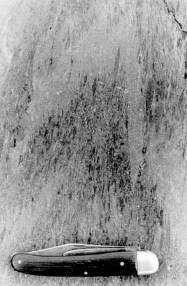Woody Island: Introduction
Introduction: Woody Island, shown on topographic maps as Green Island (map makers apparently renamed most topographic features in the area), is ca.8 kilometres NE of Carmanville in eastern Notre Dame Bay, on the "North Shore" of Newfoundland. It has excellent coastal exposure of Caradocian age Dunnage Zone (Williams, 1979) rocks, comprising greywackes, sandstones, conglomerates, siltstones, shales and mélange (Currie et al., 1980). Grading is common and there are some complete Bouma beds. Abundant detrital shale clasts are commonly visible in some coarse sediments (Fig. 1) and there are chaotic rocks containing blocks of sandstone in an apparently argillaceous matrix. The microstructure of these rocks has been describe in detail by the writer (Williams, 1983) and the relevant points are summarised here, and new observations are added.
 |
Fig. 1 Mesoscopic fold with an axial plane cleavage defined, in large part, by shale clasts. Clast colour varies from pale grey to black. Pocket knife is 10 cm long. |
Metamorphic grade appears to vary. In many outcrops, the only hand specimen indication that the rocks may have been metamorphosed is the presence of a slaty or crenulation cleavage, and where cleavage is not developed there may be no evidence of metamorphism. However, in thin section, all such rocks that have been examined contain metamorphic biotite. In other outcrops, the rocks have a phyllitic sheen and small garnets and relic porphyroblasts are visible to the naked eye. In thin section the relic porphyroblasts are seen to be largely aggregates of layersilicates pseudomorphous after the original porphyroblasts. The pseudomorphs commonly have a clear hexagonal outline and were possibly staurolite.
Two generations of folds are recognised, but there is generally only one cleavage (S2) which is axial planar to the F2 folds. This cleavage is younger than the biotite and porphyroblasts, and the lack of strongly serrate boundaries in F2- kinked biotite indicates that temperatures were too low for sufficient growth of biotite to obliterate earlier fabrics during F2. Locally however, still later contact metamorphism has converted an S2 crenulation cleavage into a coarse grained schistosity (Williams, 1985, Figs 5 & 6).